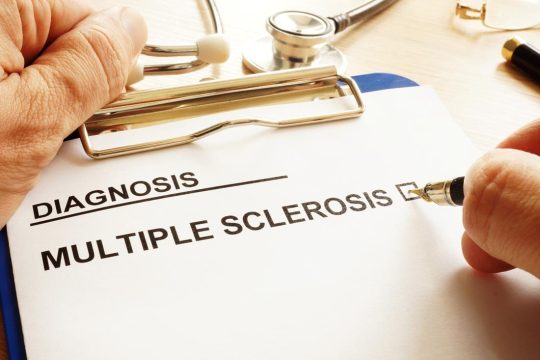Advertisment
BSH 2017: Management of Asymptomatic Follicular Lymphoma
The old mantra is that advanced follicular lymphoma (FL) cannot be cured and treatment does not influence survival but this is no longer the case – follicular lymphoma is curable in some cases …
Professor Michele Ghielmini (Bellinzona, Switzerland) gives the key points from his presentation, including a challenge to consider late effects when managing FL – something that Dr Graham Collins (Oxford Cancer and Haematology Centre) comments as being his key takeaway message from this talk.
For cases of early-stage follicular lymphoma (FL), 50% are cured with radiotherapy, and for those with grade 3B disease, 50% are cured with R-CHOP. Allogeneic stem cell transplantation will cure 50% with graft versus host disease (GvHD). Moreover, the addition of rituximab to chemotherapy clearly improved overall survival – median survival increased to about 15 years. However, advanced disease is still incurable and so it is important to enable patients to live without ill effects of disease or treatment.
It is helpful to divide patients into those with high and low tumour burdens. It is possible to have a high tumour burden without symptoms. It is also possible to have advanced, asymptomatic disease with a low tumour burden. Treatment should be given when there is asymptomatic, early-stage disease and when there is asymptomatic disease with a high tumour burden. For advanced asymptomatic disease with a low tumour burden other issues must be taken into account including the presence of fatigue, anxiety of the patient or family, concerns of the doctor and aesthetic concerns. The ESMO guidelines suggest that ‘watch and wait’ (W+W) is the most appropriate strategy at this stage but these guidelines also include the option to give rituximab monotherapy.
The UK Intergroup trial compared W+W with maintenance rituximab in patients with advanced-stage, asymptomatic, non-bulky follicular lymphoma. The results showed that ‘time to next treatment’ was significantly longer and quality of life was better in the rituximab-treated group. Overall survival (OS) did not change. “Starting chemotherapy a few years later gives a better quality of life”, noted Professor Ghielmini. Furthermore, in the pre-rituximab era three randomised trials compared W+W with immediate chemotherapy and none of these showed any differences in overall survival. However, both radiotherapy and chemotherapy have long-term, life-threatening side effects, including second malignancies, infections and cardiopulmonary disease.
Today, 90% of patients with follicular lymphoma, aged less than 40 years are alive 10 years after diagnosis and the median survival is estimated to be more than 30 years. Young patients should be spared treatment as far as possible to delay the onset of late side effects and to delay infertility or early menopause, said Professor Ghielmini. The long-term side effects of rituximab when used as maintenance treatment are not known but could include late-onset neutropaenia, hypogammaglobulinaemia, infections and resistance to vaccination. An analysis of 231 pregnancies that were exposed to rituximab showed foetal damage of various types. It is recommended that patients avoid pregnancy for 12 months after exposure to rituximab.
Early follow up (up to seven years) suggests that rituximab is not associated with second malignancies but the long term effects (up to 30 years) are as yet unknown.
It can be argued that asymptomatic patients with FL should be treated with rituximab to capture high-risk patients, reduce the risk of transformation and to allay anxiety, enable better adjustment and provide a better quality of life. However, maintenance treatment with rituximab for two years costs €40,000 – considerably more than the cost of seeing an oncologist or psychologist every month and vastly more than anxiolytic medication.
About 20% of patients are at high risk of rapid progression and these can be identified using the M7-FLIPI score. However, the implications for treatment are still uncertain – even auto-SCT does not improve survival for these cases, said Professor Ghielmini.
Treatment with rituximab does not appear to reduce the risk of transformation and W+W does not increase the risk. However, results due to be published this year might change this picture, he said.
It is often argued that early rituximab treatment can delay starting chemotherapy but rituximab given at the time of symptomatic progression can also delay the start of chemotherapy but avoids exposing the patient to long-term rituximab treatment.
Low-dose, involved field radiotherapy can be used to treat patients who are worried about enlarged lymph nodes in the neck.
Turning to dosing of rituximab, Professor Ghielmini said that the response rate is high and the duration of response depends on the dose of rituximab. In practice, retreatment with rituximab (so-called ‘stop and go’) at each relapse is no different from continuous maintenance in terms of ‘time to next treatment’ but maintenance treatment is associated with more episodes of infection.
He concluded that:
W+W remains the standard of care for asymptomatic advanced FL, although coping is an issue for patients when this strategy is adopted. Immediate treatment of asymptomatic advanced FL does not reduce the risk of transformation.
Single agent rituximab can be given at progression after W+W instead of chemotherapy and when this is done the SAKK* schedule (comprising four doses at induction and four maintenance doses over a nine month period) is a cost-effective compromise.
The results of the GALLIUM trial, in which the combination of rituximab with chemotherapy (R-Chemo) was compared with obinutuzumab with chemotherapy (G-Chemo) in previously untreated advanced stage FL showed that the obinutuzumab group had a significantly better PFS, although overall survival was unchanged. Dr Robert Marcus concluded that obinutuzumab therapy should now be considered as first line treatment for FL.
* SAKK – Schweizerischen Arbeitsgemeinschaft für Klinische Krebsforschung (Swiss Group for Clinical Cancer Research)





